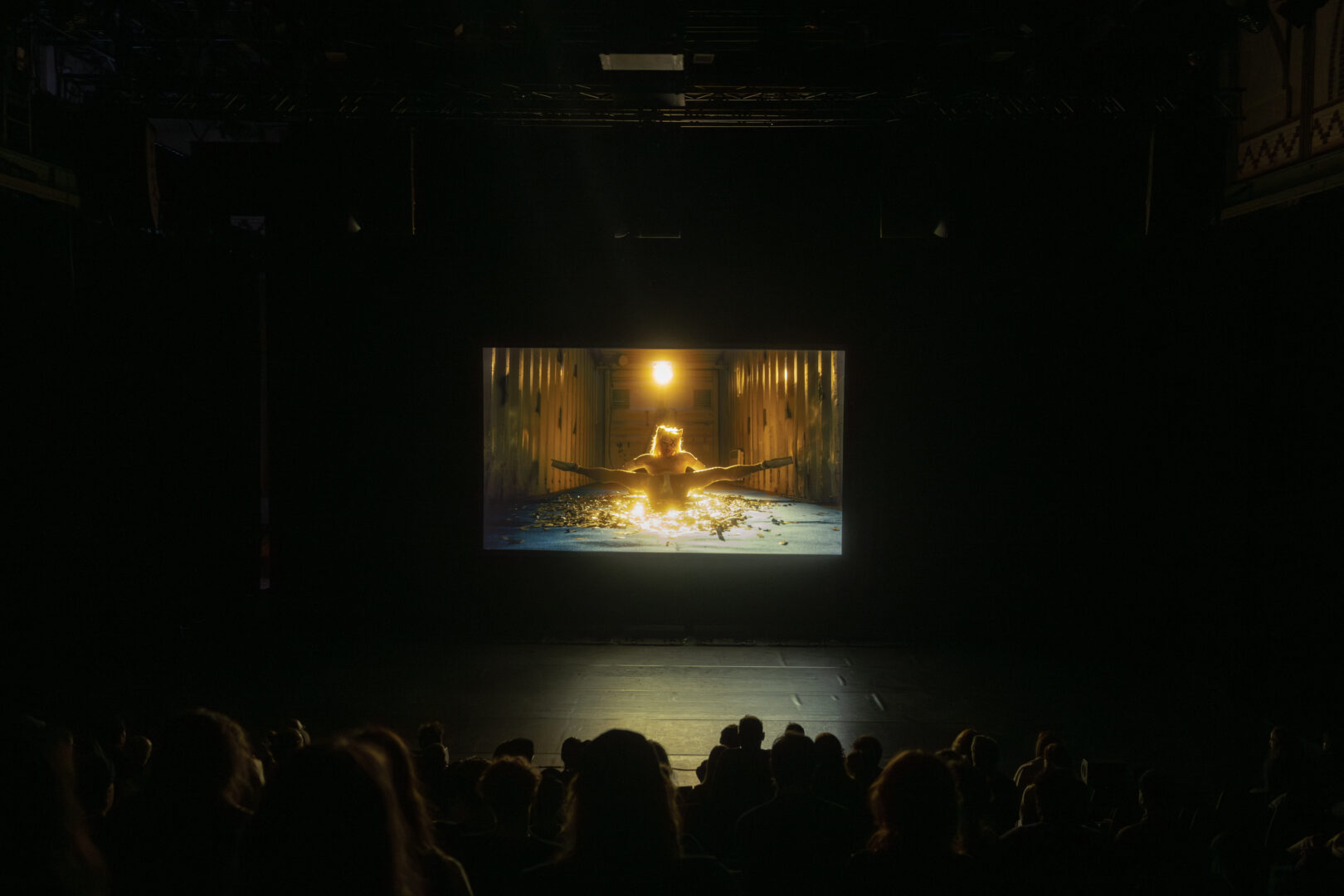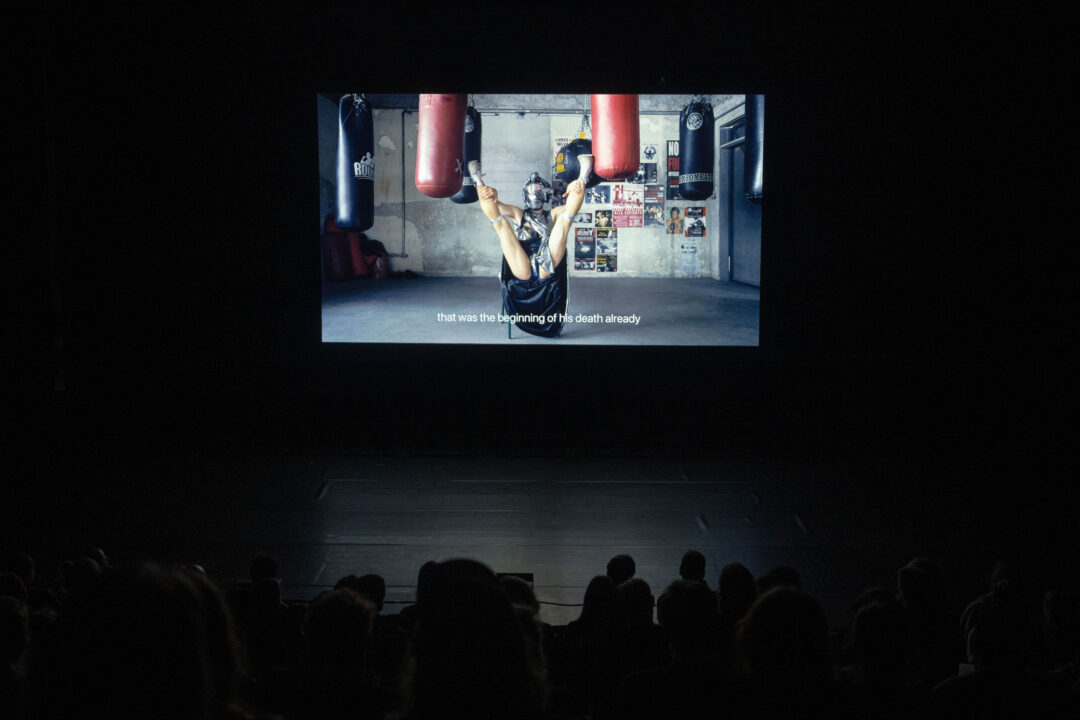Text by Ana Finel Honigman
Installation views by Camille Blake

Gustavo Gomes navigates the treacherous territories mapping desire, trauma, existential awareness, and intrapersonal understanding in his project Manhandle, a docufiction on sexual violence against men. In this intensely personal narrative, Gomes explores how we process the unruly and perilous areas where yearnings, needs, and our essential selves evolve. His nuanced and insightful work recognizes the evolving yet still imprecise vocabulary for discussing, internally and with others, the complexity of intimate experiences.
Using the body to explore inherently physical experiences, Gomes evokes profound responses in viewers beyond cerebral ethical, legal, or psychological engagement. Avoiding moralistic binaries and utilizing humor and pop-culture references to tread the gray zones of the unsayable, Gomes gives his characters space to explore themselves and their actions within the larger framework of their personal and cultural histories. While the character Carmen sings in Georges Bizet’s 1875 tragic opera, “[Love] has never, ever, known the law,” Gomes’s narrative recognizes that we, as a society, are now developing more refined methods of responding to sexual and emotional situations that were murky and hidden under veils of shame and blame.
Threads of Toxicity
As Gomes says, speaking of his protagonist in Manhandle, for some “home is only a place of toxicity.” By using movement to examine the toxic threads that impact individuals’ behaviors and experiences, he weaves a narrative full of complex characters who refuse to occupy the traditional roles of victim or victimizer but instead constantly combine vulnerabilities and predatory instincts. Gomes’s character of the cat, for instance, exemplifies the essence of sexual desire and life-force, embodying both resilience and the drive to destruction. The cat becomes the spirit through which the audience explores what philosopher Georges Bataille identifies as the key ingredients motivating most human desire: Eros (life-continuing energy) and Thanatos (the death instinct). Through her multiple deaths and resurrections, the cat constantly cycles between drives for death, fear of death, and the need for connection and erotic expression.
As the embodiment of hyper-sexuality, the cat lives with the thrill of courting and confronting death while striving to find, in the lyrics of the pop-song she sings, if “sun shines through the rain.” How does the cat’s own needs intersect with her vulnerabilities and does that complexity direct how the audience interprets its experiences? The cat struggles with the tensions that Venus expresses in Wagner’s Tannhäuser when she sings, “what you desire shall be your doom.” Yet, the cat also demonstrates perseverance and endurance, maintaining her identity through violations and injury to continue her quest for herself.


Challenging a Fixed Notion of Love
Throughout his career as a choreographer, dancer, and artist, Gomes has explored frictions between external and essential selves, as well as the interplay between objective and subjective truth, particularly within the contexts of romantic or erotic dynamics. Hilarion, his 2023 dance, explored the life-cycle of lust and romantic bonds. As a modern and more maturely nuanced adaptation of Giselle, Hilarion challenged the static notion of love in much traditional dance—where characters’ infatuations are conflated with lasting commitment. The lies, evasions, and loss are not seen as beautiful sacrifices to love, as in the original, but more common hurtful manipulations familiar to most adult audience members whose own romantic histories include moments of betrayal, silencing, conflicting signals, and confusion. “What is the guilt,” asks Gomes when reflecting on the themes he explored in Hilarion, which evolved into a complex meditation on individuals’ personal understandings of monogamy and commitment. “What is fidelity?” he questions, “What is the idea of fidelity? Is it being together? Is it the emotion of being together but with other people? What is the network? Why do we call someone or something ‘faithful’?”
Drawn from Heinrich Heine’s epic poem, “Die Lorelei,” Gomes’s Lorelei: Maneater tells of a siren looking inward to understand the force of her own erotic power. While recognizing her influence, Lorelei reconciles being both object and subject of desire. Her experience as the cause of “wild and aching woe” exists both for her and her victims, who resist or willingly submit to her call. For Gomes, the focus becomes Lorelei’s own processing of her power. Meanwhile, the abuse of authority and poisonous influence of power to direct our perceptions was the subject of Gomes’s immersive theater performance The Golden Age of Alternative Truth. In this 2019 work, Gomes uses his hyper-real aesthetic and assertive movements to deconstruct historic and current abuses of information and trust. The struggle to construct a relationship to reality becomes a physical battle for Gomes in this work.
Trauma and the Physical Self
For Manhandle, created in the framework of Forecast with artist Roee Rosen as his mentor, Gomes revisits many of these themes but cast into the fraught, cold, and often silenced landscape of men’s sexual trauma.
Here, Gomes interrogates how we digest what we’ve experienced through our desires and abilities to connect—as people, professionals, and a community. He asks how we develop a sense of “home” through familiarity, even when the familiar is laced with trauma and harm. Gomes explores men’s histories of trauma and theories of how trauma shapes our physical selves, health, and relationships with our bodies, as popularized by Bessel van der Kolk in The Body Keeps Score, by tracing his characters’ lived experiences through their movements and physical selves. Violence, lust, and hurt are theatrically expressed through Gomes’s choreography while artistic expression is promoted as a healing process. As Gomes describes, Manhandle has become a work where “the act of making art has a healing influence in the lives of men I meet.” By addressing hidden histories of exploitation and suffering for men, the Manhandle promises to accomplish art’s great alchemy of turning private pain into shared healing and transcendence.
You are currently viewing a placeholder content from Vimeo. To access the actual content, click the button below. Please note that doing so will share data with third-party providers.
More Information